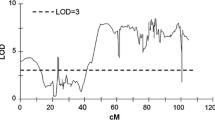Summary
Seven varieties and 57 spontaneous or induced in vitro mutant lines (20 macromutant and 37 micromutant events) of potato were tested by starch gel electrophoresis for ADH, GOT, PGI, PGM, ACO, IDH, MDH and 6PGDH isozymes in tuber extracts. The data showed that in contrast to variety comparisons, the isozyme patterns rarely differentiate mutant lines which have altered morphological traits. But trying to identify isozyme differences in mutants can still be useful for a chimeric structure for GOT-2 alleles in a mutant from Atlantic and a new tuber specific locus for 6PGDH in mutants from Russet Burbank were found.
Similar content being viewed by others
Abbreviations
- ACO:
-
aconitase
- ADH:
-
alcohol dehydrogenase
- GOT:
-
glutamate oxaloacetate transaminase
- IDH:
-
isocitric acid dehydrogenase
- MDH:
-
malate dehydrogenase
- 6PGDH:
-
6-phosphogluconate dehydrogenase
- PGI:
-
phosphoglucoisomerase
- PGM:
-
phosphoglucomutase
- SGE:
-
starch gel electrophoresis
- EMS:
-
ethyl metanesulfonate
References
Allicchio, R., C., Antonioli, L., Graziani, R., Roncarati & C., Vannini, 1987. Isozyme variation in leaf-callus regenerated plants of Solanum tuberosum. Pl. Science 53: 81–86.
Ball, S.G. & P., Seilleur, 1986. Characterization of somaclonal variations in potato: a biochemical approach. In: J., Semal (Ed.). Somaclonal variations and crop improvement, Martinus Nijhoff Publishers, Dordrecht, Boston, Lancaster, 229–235.
Bailey, D.C., 1983. Isozymic variation and plant breeders' rights. In: S.D., Tanksley & T.J., Orton (Eds.). Isozymes in plant genetics and breeding, part A. Elsevier Science Publishers, Amsterdam, 425–440.
Boersig, M. & D., Mitten, 1990. Effects of tissue source and mutagen treatment on variability of regenerated potato lines. Amer. Potato J. 67: 54.
Bonierbale, M.W., M.W., Ganal & S.D., Tanksley, 1990. Applications of restriction fragment length polymorphisms and genetic mapping in potato breeding and molecular genetics. In: M.E., Vayda & W.D., Park (Eds.). The molecular and cellular biology of the potato, C.A.B. International, Oxon, U.K., 13–24.
Douches, D. & C., Quiros, 1987a. Additional isozyme loci in tuber-bearing Solanums: inheritance and linkage relationships. J. Heredity 79: 377–384.
Douches, D. & C., Quiros, 1987b. Use of 4x−2x crosses to determine gene-centromere map distances of isozyme loci in Solanum species. Genome 29: 519–527.
Douches, D., K., Ludlam & E., Varga, 1989. Electrophoretic survey of North American potato varieties. Amer. Potato J. 66: 518.
Groza, H., 1980. Possibilités d'utiliser la mutagenèse en vue de l'amélioration de la pomme de terre. Bulletin de l'Académie des Sciences Agricoles et Forestières, Romania, 10: 25–35.
Groza, H., S., Love & D., Hane, 1989. Repeatability within standard varieties as a basis for clonal selection in a possible variety improvement program. Amer. Potato J. 66: 521.
Holm, D.G., 1988. Sangre selection studies: 1. Selection and comparative trials. Amer. Potato J. 65: 21–26.
Love, S.L., 1989. Selection of gamma ray induced blackspot bruise resistant potato mutants from the susceptible cultivar Lemhi Russet. Amer. Potato J. 66: 531.
May, B., J.E., Staub & L.J., Kuhns, 1982. Potato cultivars: Genetic variation within putative clones. Amer. Potato J. 59: 179–187.
Moore, G.A. & G.B., collins, 1983. New challenges confronting plant breeders. In: Tanksley and T.J., Orton (Eds.). Isozymes in plant genetics and breeding, part A. Elsevier Science Publishers, Amsterdam, 25–58.
Quiros, C.F. & N., McHale, 1985. Genetic analysis of isozyme variants in diploid and tetraploid potatoes. Genetics 111: 131–145.
Ruiz-Nieto, A., M., Vilchez, A., Chueca & J., Lopez-Gorge, 1989. Analisis varietal de Solanum tuberosum por electroen-focque analitico de proteinas del suero del tuberculo. Rev. Agroquim. Tecnol. Aliment. 29: 340–350.
Shepard, J.F., D., Bidney & E., Shahin, 1980. Potato protoplasts in crop improvement. Science 208: 17–24.
Snedecor, G.W., 1956. Statistical methods, applied to experiments in agriculture and biology. The Iowa State College Press, Ames, Iowa, 221.
Sree Ramulu, K., 1986. Origin and nature of somaclonal variation in potato. In: J., Semal (Ed.). Somaclonal variations and crop improvement, Martinus Nijhoff Publishers, Dordrecht, Boston, Lancaster, pp. 188–121.
Suurs, L.C.J.M., E., Jongedijk & M.M.C., Tan, 1989. Polyacrylamide gradient-gel electrophoresis: a routine method for high resolution isozyme electrophoresis of Solanum and Lycopersicum species. Euphytica 40: 181–186.
Thomson, A.J., 1987. The potential value of somaclonal variants in potato improvement. In: G.J., Jellis & D.E., Richardson (Eds.). The production of new potato varieties: technological advances, Cambridge University Press, Cambridge, New York, Melbourne 327–330.
Van, Harten, A.M., 1978. Mutation breeding techniques and behavior of irradiated shoot apices of potato. Pudoc, Wageningen, 132 pp.
Author information
Authors and Affiliations
Rights and permissions
About this article
Cite this article
Groza, H., Kahn, R. Use of isozyme patterns in characterization of potato mutant lines selected for agronomic quantitative traits. Euphytica 57, 189–194 (1991). https://doi.org/10.1007/BF00039665
Received:
Accepted:
Issue Date:
DOI: https://doi.org/10.1007/BF00039665




